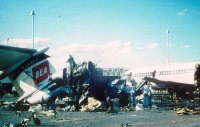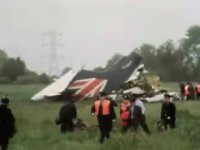
Accidents and Incidents
HS Trident 1C, BEA (HSA), G-ARPY, at Felthorpe, UK, 3/6/1966
| The aircraft has departed Hawker Siddeley's factory airfield at Hatfield in the late afternoon to conduct stalling tests over East Anglia. On the fourth stall test, the recovery systems were deliberately made inoperative as part of the test, but recovery action from the pilots was left too late and the aircraft first entered a superstall (aka deep stall or stable stall) from which it then entered a flat spin and could not be recovered. All four test crew were killed. |
HS Trident 1E, Kuwait Airways, 9K-ACG, at Kuwait Intl Airport, Kuwait, 30/6/1966
| A poor approach to the airport at too high a rate of decent and with insufficient engine power caused the aircraft to crash land three and a half miles short of the runway. There were no fatalities but the aircraft was written off. |
HS Trident 1C's, BEA, G-ARPI and G-ARPT, at Heathrow Airport, UK, 3/7/1968
 |
An airspeed Ambassador, G-AMAD of BKS Air Services suffered a failure in the flap operating mechanism on one wing, causing the aircraft to bank to the left and lose height. It touched down and left the runway, colliding with two parked Tridents, 'PT and PI. 'PT's entire tail section was torn off whilst 'PI suffered significant damage to its tail. No one was onboard either Trident at the time, but there were six human fatalities on the Ambassador and also a number of equine fatalities. 'PT was written off and after much work, 'PI was repaired. |
HS Trident 1C, BEA, G-ARPS, at Heathrow Airport, UK, 29/7/1969
| A cabin fire occurred onboard the aircraft whilst parked and it was written off. |
HS Trident 1E, CAAC, 256, in Mongolia, 13/9/1971
| After an alleged failed coup attempt, a number of senior Chinese officials including Lin Biao (although this was officially denied) were defecting to the USSR when the aircraft they were travelling on crashed, either due to lack of fuel or a missile impact. Details of Lin's death were kept secret for a year and even today the specific events leading to and surrounding the crash are debated and disputed. |
HS Trident 1C, BEA, G-ARPI, at Staines, UK, 18/6/1972
 |
British European Airways operated flight BE548 departed Heathrow's runway 28R at eight minutes past four in the afternoon. As the aircraft climbed its speed was consistently below that that it should have been and this appears to have gone unnoticed. Then at 1770ft and 162kts IAS whilst in a 20 degree bank, the leading edge droops (high lift devices) were retracted. Correct retraction conditions dictated altitude >3000ft, IAS >225kts and wings level. The aircraft entered a stall which was recovered by the stick pusher (automated recovery system). No further action appeared to be taken and the aircraft entered a second stall. This time the stall recovery override lever was pulled and the aircraft entered a deep stall, descending rapidly in a flat attitude with a very low forward airspeed before impacting the ground near the town of Staines. All 118 persons onboard were killed but thankfully no-one on the ground was injured. Some form of human error or errors appear to have contributed to the crash but without a cockpit voice recorder it was not possible to determine with total certainty what did indeed happen. Factors may have included a heart condition suffered by the Captain that was discovered in the post-mortem or inexperience and slow reaction to the situation by the P2 pilot. As a result of this accident it was recommended that all airliners be fitted with a cockpit voice recorder. |
HS Tridents at Nicosia, Cyprus, 22/6/1974
| Turks and Greeks have long fought over the island of Cyprus and in 1974 a war broke out during which aircraft of the Turkish air force strafed Cyprus Airways' aircraft at the civilian Nicosia Airport. Trident 2E 5B-DAB was damaged, 5B-DAC was also damaged but later repaired and returned to BA, 5B-DAD also went to BA, but 5B-DAE was completely destroyed. |
HS Trident 1E, British Airways, G-AVYD, at Bilbao, Spain, 15/9/1975
| On takeoff the Captain decided to abort to an apparent deceleration caused by the aircraft encountering standing water on the surface. It was unable to stop in time and went off the end of the runway. Noone was killed but the aircraft was badly damaged and therefore written off. |
HS Trident 1C, British Airways, G-ARPC, at Heathrow Airport, UK, 28/12/1975
| A fire broke out in the cabin whilst the aircraft was parked and it was written off. |
HS Trident 3B, British Airways, G-AWZT, over Yugoslavia, 10/9/1976
| British Airways airways flight BA475 to Istanbul from London was over Yugoslavia at the same time as Inex Air Adria flight JP550 - A DC-9 - heading for Cologne. The air traffic control at Zagreb was understaffed and the controllers struggling to cope. It was just around the time of a handover of shifts between two controllers. The Index Adria aircraft was cleared to FL350 (2,000ft above the Trident's altitude) and frantic efforts to alert the Inex Adria pilot were made in Croatian and not English, thus denying important information from the British crew. The DC-9 levelled out and held its altitude, but ironically this resulted in the two aircraft colliding and the deaths of all 176 people onboard both aircraft. |
HS Trident 2E, CAAC, B-274, Guangzhou or Beijing, 14/3/1979
| The aircraft was allegedly taken by an unqualified pilot, from one or other airport and subsequently crashed after takeoff into a local factory causing a large number of fatalities on the ground. |
HS Trident 2E, CAAC, B-266, at Mt.Yangsu, China, 26/4/1982
| The aircraft crashed into a mountain whilst on approach to Guilin airport. |
HS Trident 2E, CAAC, B-260, at Fuzhou Airport, China, 27/2/1983
| Aircraft overran the length of the runway on landing roll-out, causing the nose gear to collapse. |
HS Trident 2E, CAAC, B-296, at Chunchon, South Korea, 5/5/1983
| The aircraft was hijacked and flown to Chunchon, South Korea where it overran the runway but nevertheless, the aircraft and its passengers were later returned to China unharmed. |
HS Trident 2E, CAAC, B-264, at Guilin Airport, China, 14/9/1983
| An Il-28 collided with the aircraft whilst taxiing resulting in 11 fatalities aboard the Trident. |
HS Trident 2E, CAAC, B-2218, Kowloon, Hong Kong, 31/8/1988
| Whilst landing in poor weather and low visibility conditions, the starboard wing touched the ground and the starboard undercarriage collapsed. The aircraft veered off the runway and into Kowloon harbour. There were 7 fatalities and 89 survivors. |
HS Trident 2E, Air China, B-2208, Guilin Airport, China, 22/3/1990
| The aircraft overran the runway after a late touchdown on a wet runway. There were no fatalities but the aircraft was written off. |